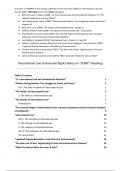Summary
Summary International Law and Human Rights Notes on *SOME* Readings - GRADE 8,0
- Course
- Institution
Summary of *SOME* of the reading materials for the final exam (2023) for International Law and Human Rights. INCLUDES notes from (Total: 20 pages): Beth Simmons’s chapter (2008) “11. International Law and International Relations” in “The Oxford Handbook of Law and Politics” Oxford Hand...
[Show more]



